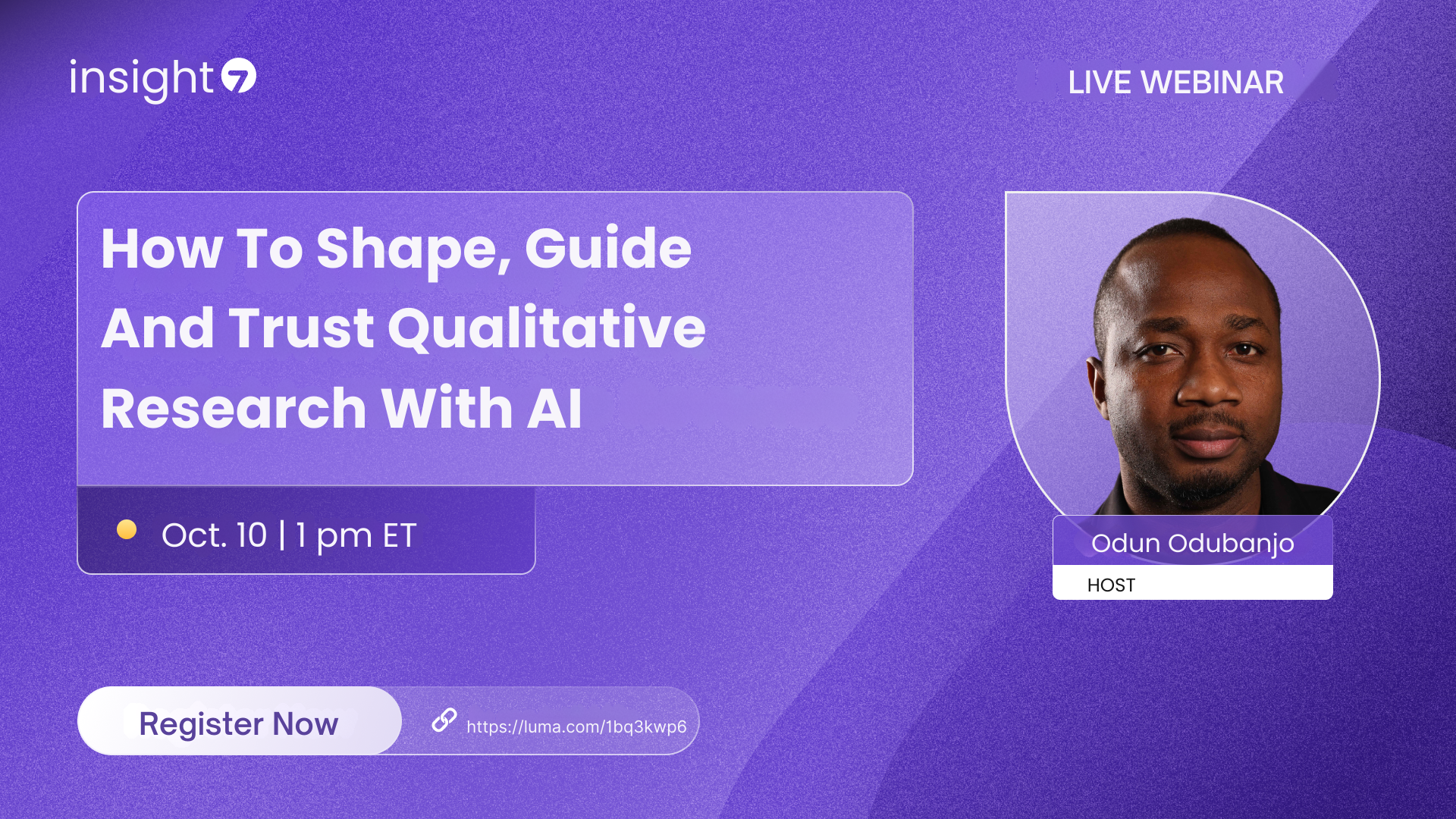Text Analytics Basics: Step-by-Step Guide
-
Bella Williams
- 10 min read
In today’s data-driven world, understanding the vast amounts of text generated every day has never been more crucial. This Text Analysis Guide aims to equip you with the essential knowledge to navigate the complexities of text analytics. Whether you're a novice or seeking to enhance your skills, grasping the foundational concepts is key to unlocking valuable insights hidden within textual data.
Diving into text analytics opens doors to improved decision-making and a deeper understanding of customer behavior. By following our step-by-step approach, you'll learn how to collect, clean, and analyze data effectively. This introduction sets the stage for a comprehensive understanding of text analysis, allowing you to convert raw text into meaningful insights that can drive action in your organization.
Generate visualizations from your qualitative data. At Scale.

Unveiling Text Analytics: A Comprehensive Text Analysis Guide
Understanding text analytics begins with recognizing its transformative power in processing and interpreting language data. This comprehensive text analysis guide offers insights into extracting meaningful information from textual sources. Dive into the various applications of text analytics, from sentiment analysis to trend identification, illustrating how this discipline can revolutionize decision-making across industries.
To effectively utilize this guide, consider the following key elements:
Foundational Terminologies: Familiarize yourself with essential terms like tokenization, stemming, and natural language processing. Each plays a crucial role in text analysis, enabling a clear understanding of processes.
Predictive Analytics: Learn how text analytics leverages historical data to forecast future trends. Properly applied, this can enhance strategic planning and boost organizational outcomes.
Data Cleaning: Understand the importance of preparing your text data by removing irrelevant information and formatting inconsistencies. This step is vital for obtaining accurate insights.
By mastering these foundational aspects, you can confidently navigate the intricate world of text analytics and extract valuable insights from your data.
Text Analysis Guide: Core Concepts and Terminologies
Understanding the core concepts and terminologies in text analysis is essential for effective analytics. The Text Analysis Guide outlines key terminology that underpins the methodology of text analytics, making it easier to communicate and comprehend the processes involved. Terms such as "natural language processing" and "sentiment analysis" are frequently used but can be confusing without context. A solid grasp of these terms enhances collaboration across teams, ensuring everyone is aligned in their objectives.
Crucial components include data collection, data processing, and analytical techniques. Familiarizing oneself with these aspects provides clarity on how to manipulate and analyze textual data effectively. Different methods, such as topic modeling and text mining, allow analysts to extract valuable insights from large unstructured data sets. This foundational knowledge is vital in navigating the complexities of text analysis and deriving actionable insights for decision-making.
Tools and Technologies: An Essential Text Analysis Guide
Tools and technologies are critical components in any text analysis guide. They empower users to efficiently process, analyze, and derive insights from vast amounts of text data. The right tools can significantly enhance the accuracy and effectiveness of your analysis, allowing for a deeper understanding of patterns, trends, and sentiments present in the data.
Selecting appropriate technologies begins with identifying the specific needs of your project. Various tools can serve distinct purposes, from data collection to analysis and visualization. A well-rounded toolkit may include Natural Language Processing (NLP) software, data visualization platforms, and linguistic analysis tools. Each technology fulfills a unique role, whether it’s cleaning data, identifying key themes, or generating visual summaries. Understanding these tools ensures that users can navigate the complexities of text analytics confidently and successfully, ultimately transforming raw data into meaningful insights.
Evaluate Performance on Customer Calls for Quality Assurance.
Step-by-Step Text Analysis Guide: From Data to Insights
To transition from raw data to valuable insights, follow our carefully structured text analysis guide. This step-by-step approach ensures clarity at each stage, empowering you to make informed decisions. First, you will begin with data collection techniques that enable you to gather relevant content effectively. Once you have gathered your data, proper cleaning is essential. This step ensures consistency and removes any discrepancies that could skew your analysis.
Next, choosing the right analytical method is crucial. Various techniques exist, tailored to specific types of data and desired outcomes. Once your chosen methodology is executed, interpreting the results will reveal actionable insights. Understanding these insights allows you to draw meaningful conclusions, leading to informed strategies and decisions. Following this text analysis guide enables anyone, regardless of expertise, to convert data into valuable knowledge easily.
Text Analysis Guide: Preparing Your Data
To effectively prepare your data for text analysis, begin by understanding the crucial steps outlined in this Text Analysis Guide. Data collection is your first priority; it involves gathering relevant text from diverse sources such as customer feedback, social media, or survey responses. Ensure that the data you collect is representative of the insights you wish to uncover, as this foundation sets your entire analysis in motion.
Next, data cleaning is essential. This step involves removing inconsistencies, duplicates, and irrelevant information from your dataset. Consider employing techniques like tokenization and normalization to format your text appropriately. By meticulously preparing your data in this way, you enhance the reliability of your insights, ultimately leading to more precise and actionable conclusions. Remember, an organized and clean dataset is the bedrock of successful text analytics, paving the way for meaningful insights and informed decisions.
- Step 1: Data Collection Techniques
Data collection is a foundational step in any text analytics process. In this Text Analysis Guide, we explore various techniques crucial for gathering relevant data. Effective data collection methods include surveys, interviews, and social media scraping. Each technique offers unique benefits, facilitating insight into customer sentiments and trends.
Surveys are an invaluable tool for collecting quantitative data directly from users. By designing targeted questions, you can capture specific feedback on your products or services. Interviews, on the other hand, provide qualitative insights through in-depth conversations. They allow for deeper exploration of emotions and opinions. Lastly, social media scraping taps into vast pools of user-generated content, revealing real-time sentiments and trends. Understanding these techniques will significantly enhance the effectiveness of data collection in your text analytics journey.
- Step 2: Data Cleaning Essentials
Data cleaning is a pivotal step in preparing your dataset for effective text analysis. The primary goal here is to ensure that the data is accurate, consistent, and usable. This involves identifying and correcting errors in the data, which can significantly affect your analysis outcomes. Text data often contains inconsistencies like misspellings, irrelevant information, and duplicates, all of which can skew results and lead to misleading conclusions.
To streamline the data cleaning process, focus on the following key areas:
Removing Duplicates: Eliminate repetitive entries to ensure that each piece of data contributes uniquely to the analysis.
Standardizing Formats: Ensure that data entries follow a uniform format, which facilitates easier processing and comparison.
Handling Missing Values: Decide whether to fill in gaps or remove incomplete entries entirely.
Normalizing Text: Convert all text to a consistent case, remove special characters, and correct obvious spelling errors.
By following these essentials, you set a strong foundation for effective analysis in your text analysis guide. The cleaning process enhances the reliability of your insights, which is crucial for informed decision-making.
Text Analysis Guide: Executing the Analysis
Executing the analysis involves a systematic approach to transforming raw data into meaningful insights. The key to successful text analysis is understanding which analytical methods align with your objectives. Start by evaluating various techniques such as sentiment analysis, topic modeling, or keyword extraction. Each method serves distinct purposes based on your data and desired outcomes. Once you select the method that best fits your needs, apply it to the prepared data you gathered in earlier steps.
Next, interpreting results is crucial for deriving actionable insights. Review the findings critically and identify patterns or trends that emerge from the analysis. Collaborate with stakeholders to ensure these insights align with organizational goals and decision-making processes. Remember, the goal is to not just analyze the data, but also to leverage it for tangible outcomes. This process brings together the tools you’ve learned about and places them in a context that drives progress.
- Step 3: Choosing the Right Analytical Method
Choosing the right analytical method is crucial in text analytics, as it directly influences the quality of insights derived from your data. Various analytical approaches exist, each tailored to specific objectives and types of data. Start by identifying the purpose of your analysis. Are you looking to uncover sentiment, classify content, or detect trends? This initial clarity guides your choice of method. Common techniques include sentiment analysis, topic modeling, and keyword extraction, each suited for different types of inquiries and data structures.
Next, consider the nature of your data. Is it structured or unstructured? Unstructured data often requires natural language processing techniques, while structured data may be approached with statistical methods. Additionally, assess the tools and resources available to you. Some methods demand advanced software or higher computational power, making feasibility a vital factor in your decision-making process. By meticulously assessing these elements, you can select the most effective method, ensuring a meaningful, insightful text analysis journey.
- Step 4: Interpreting Results for Actionable Insights
Interpreting results plays a vital role in a successful text analysis journey. Once you've gathered and processed your data, it's time to distill it into actionable insights. Begin by identifying key trends and patterns that emerge from the data. For instance, if customer feedback indicates recurring pain points, these insights can drive improvements in products or services.
Next, contextualize your findings within the broader objectives of your organization. Analyzing the frequency of certain keywords, sentiments, or themes can reveal underlying customer needs and preferences. By aligning these insights with strategic goals, you pave the way for informed decision-making. Remember, actionable insights should empower you to take steps toward bettering customer experiences. Use visualizations, like dashboards or reports, to present your findings clearly and effectively. This clarity is crucial for relevant stakeholders to grasp the implications of your analysis and implement necessary changes.
Conclusion: The Path Forward in Text Analysis Guide
As we conclude our Text Analysis Guide, it is crucial to reflect on the journey we have taken. Understanding the fundamentals of text analytics equips you with the ability to derive meaningful insights from unstructured data. By following the structured steps outlined, you have learned how to prepare, analyze, and interpret data effectively. This knowledge enables you to make informed decisions based on the information gathered.
Looking forward, the path in text analysis is filled with opportunities for improvement and innovation. As technology evolves, so do the methods available for analysis. Embrace these advancements, and continue exploring new tools and techniques to enhance your text analytics proficiency. With a commitment to continuous learning, you'll be well-equipped to navigate the future of text analytics and its impact on decision-making.







